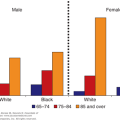Palliative Care: Introduction
Much attention has been focused on the importance of making end-of-life (EOL) care decisions before one is in a crisis situation. Some older adults, however, are ambivalent about what they want at the end of life and may change their minds about treatment options when actually threatened by an illness that can cause death (Caron, Griffith, and Arcand, 2005; Cherlin et al., 2005). An option that allows for realistic EOL supportive care without rescinding all efforts at treatment is palliative care. Palliative care is focused on symptom management and relieving suffering and improving quality of life of individuals rather than focusing on cure and lengthening of life. Avoidance of unnecessary, and potentially harmful, tests is initiated, and care is focused on comfort. Palliative care is a philosophy of care that is provided simultaneously with all other appropriate medical management of the patient.
Hospice differs from palliative care. Hospice is a comprehensive care system for patients with limited life expectancy who are living at home or in institutional settings. Hospice is a Medicare benefit that was established in 1982. To be eligible for hospice, the patient’s primary health-care clinician must certify that the patient has a remaining life expectancy of approximately 6 months or less, and the patient must elect hospice and agree to accept care from an identified hospice team. The patient’s primary health-care clinician may elect to continue to provide care for the patient and work with the hospice team. Services provided through hospice are shown in Table 18–1. Hospice services also include coverage of necessary supplies such as a bedside commode or medications.
Service provided | Description |
|---|---|
Nursing | Registered nurses coordinate the care for every patient, provide direct patient care, and check symptoms and medication. Patient and family education is an important part of every visit. The nurse is the link between the patient and his or her family and the physician. The nurse can also help evaluate the patient’s condition. |
Social services | The social worker provides advice and counseling to the patient and all family members during the crisis period. The social worker assists other care team members in understanding the family dynamics and acts as an advocate for the patient and the family in making use of community resources. |
Physician services | The patient’s physician approves the plan of care and works with the hospice team. In a full hospice program, a hospice medical director is available to the attending physician, the patient, and the hospice care team as a consultant and a resource. |
Spiritual/counseling | Clergy and other counselors are available to visit and provide spiritual support to the terminally ill at home. Programs also use churches and congregations to aid the patient and family as requested. |
Home health care/homemaker | Home care aides provide personal care for the patient, such as bathing, shampooing, shaving, and nail care, and homemakers may be available for light housekeeping or meal preparation. |
Continuous home health care | If the patient’s needs require it or if the family can no longer manage the level of care required around the clock, hospice staff will provide care for 8- to 24-hour periods on a short-term basis. |
Therapy/rehabilitation services | Daily living tasks such as walking, dressing, or feeding oneself can become frustrating and impossible during an illness. Therapists help the patient develop new ways to accomplish these tasks. |
On-call team support | A hospice team member is on call 24 hours a day, 7 days a week. If a problem should arise, the team member may offer advice over the phone and, if necessary, make a visit. |
Respite care | To provide relief for family members, the hospice may arrange a brief period of in-patient care for the patient. |
Bereavement counseling | Bereavement is the time of mourning that we all experience following a loss. The hospice care team works with surviving family members to help them through the grieving process. Support may include a trained volunteer or counselor visiting the survivors at specific periods during the first year, or phone calls and/or letter contact and the opportunity for family members to participate in support groups. The hospice will refer survivors to medical or other professional care if necessary. |
Initiating the discussion
Clarifying the prognosis
Evaluating the patient/family
Identifying end-of-life goals
Developing a plan of care
Step | Description |
|---|---|
Step I: Initiating the discussion | Schedule a private location and adequate time for this discussion. Plan what you will say to the patient/family. Gather current evidence-based facts/numbers to present (eg, percentage of older adults likely to survive CPR after the age of 80). |
Step II: Evaluating the patient/family | Ask the patient/family to state what their thoughts are about the older adult’s current status. Ask the patient/family to state their goals in terms of care (eg, focus on life prolongation versus quality of life). Ask if the patient/family is willing to discuss options in care. |
Step III: Clarifying the prognosis | Provide the facts on current status, life expectancy, and anticipated disease(s) trajectory. If new diagnosis, provide specific detail (eg, this is a malignant melanoma with some evidence of spreading). Deliver information in straightforward way; don’t use euphemisms; use words the patient/family can understand. |
Step IV: Identifying end-of-life goals | Provide treatment choices and options with known evidence for outcomes. Focus on care and what will be provided. Establish goals based on all given information. |
Step V: Developing a plan of care and ongoing support | Establish a current plan of care (eg, address symptoms or current problems). Provide ongoing support to the patient and family for the choices they have made. Separate personal feelings from patient/family choices. Focus on how ongoing care will occur and what will be provided. |
A major emphasis during all discussions of end-of-life care should be on the types of care that will be provided. Statement such as “there is nothing more we can do for you” should be avoided. Rather, the discussion should focus on what types of care interventions will be provided (eg, pain medications, positioning therapies as appropriate, nonpharmacologic pain-relieving modalities). Following these steps can help to assure that communication is clearly provided, fears are allayed, and the patients are helped to achieve the goals they want at the end of life such as dying with minimal pain.
It is important to initiate discussions about care philosophies regarding the end of life with patients and their families. While it may be difficult to do this during the first patient visit, it is helpful to have the discussion early in the provider–patient relationship. One option is to ask the patient/family if they have had discussions about EOL care and, if so, to ask them to bring any documents addressing preferences to the next appointment. If this has not been previously addressed, then a plan to discuss this in more detail at the next visit can be initiated.
For older adults in long-term care settings, one important fact to obtain and clarify during the first visit with a patient involves identifying who will be the primary/first contact to call with changes in the patient’s condition (see Chapter 17). When there are differences of opinion between siblings or caregivers about how treatment should proceed (eg, to go to the hospital or not), the clinician may be asked to facilitate a discussion around the pros and cons of different treatment options. While time consuming, these conversations can help to ease the anxiety experienced among the caregivers and help the entire family feel comfortable with the decisions that are made. The primary care clinician may need to help families explain difficult situations to a patient. Examples include such things as helping a patient with mild cognitive impairment understand that refusing dialysis may result in death. The clinician may also have to interpret behavioral responses to interventions for families of individuals who are not able to verbally express their thoughts (eg, pulling out tubes or turning down feedings may be indicative of refusal).
Slow Medicine
Slow medicine is a philosophy of care that was developed to help older adults and their families and caregivers manage some of the changes that occur with aging and the declines that commonly occur (McCullough, 2008). Slow medicine is a common sense approach to care of older adults in which careful consideration is given to the pros and cons of each treatment option. The underpinning of slow medicine is a sustained relationship with a primary care clinician who the patient and family come to trust. This sustained relationship allows time for EOL issues to be broached and revisited, a situation in stark contrast to the requirement that such topics be broached on admission to a medical facility. Decisions are strongly based on quality-of-life factors, comfort, and the risk of doing more harm than good with any given intervention. In many situations in geriatrics, a “tincture of time” may in fact be the best approach to see if a symptom will resolve prior to initiating an intervention that may cause harm (eg, an antibiotic with side effects). The slow medicine philosophy can be used to help with decisions around prevention practices (eg, use of statins) as well when managing acute situations.
Older adults and/or families often request that tests and treatments be provided for themselves or their loved ones that may not necessarily be of benefit to them. In addition, clinicians may recommend tests and procedures based on guidelines and data provided for younger individuals or as a way to cover all possible outcomes. Increasingly, there are beliefs and concerns over testing and subsequent harm to older adults. In response to these concerns, the ABIM Foundation (2012) joined with nine leading medical specialty societies to develop a list of tests and procedures that should not be recommended for older adults. The goal of choosing wisely is to help health-care providers and older adults think about and talk about undergoing expensive interventions that are not likely to be beneficial for optimizing quality of life.
Helping Older Adults and Families Understand and Decide on Palliative Care Approaches
Discussing EOL care and decisions about how to approach care at the later stages of an older individual’s life are difficult. Usually these discussions occur during a significant change in the patient’s condition, following an acute event such as pneumonia or a fall, when a patient is suffering and aggressive treatment is not likely to help that suffering, around an aging milestone such as turning 100, or simply when the patient/family wants to discuss them. As delineated in Table 18–2, clinicians should use a step approach and discuss prognosis clearly, offer hope as needed, provide evidence-based options, coordinate transitions of care as needed and progression of disease, and relieve suffering, both physical and emotional. It is critical to determine what the patient/family wants to know and how much information they want to receive, be prepared to provide care and treatment-related options, be unbiased and open to what the patient/family wants, and be prepared to offer emotional support.







